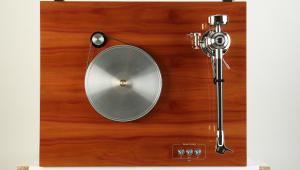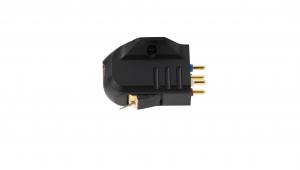Dynavector Drt Xv 1t (£5500)
Outstanding hi-fi products have never been designed by committee. They nearly always originate in the mind of one very gifted individual, like the late Dr Noboru Tominari.
Dr Tominari was a professor of engineering at Tokyo State University when he launched the Dynavector company in 1975. He developed the first successful high-output moving-coil, which did not need a special step-up device but worked with the moving-magnet phono input that was then standard on every hi-fi amplifier.
The early Ultimo 10x, which was so popular in the UK in the late 1970s, was the ancestor of the today’s high-output Dynavector 10X5.
LITTLE GEM
Later, Dr Tominari was the first to offer a cartridge with a solid gemstone cantilever, when Dynavector launched the Karat series. But his final contribution to the art and science of cartridge design was the XV-1, along with its successor, the XV-1s of 1999. This did not use the Karat type of short gemstone cantilever, but did offer a newly-designed generator system.
After Dr Tominari passed away in 2002, the process of development and refinement continued for a few more years, until the company was finally ready to unleash the XV-1t, reviewed here. When the enticing walnut box arrived, I couldn’t wait to try it, but made myself spend the time carefully setting it up on the SME 10 before I sat down to listen.
SHEER CLARITY
Rounding up the usual suspects, I started with Rob Wasserman’s Duets [GRP 97 121]. Jennifer Warnes’ ‘Ballad Of The Runaway Horse’ vocal was delivered with a lovely presentation and true delicacy, the tiny breath sounds well captured.
Imagery was well-centred and precise, with a real sense of distance to the background vocals. But on this track I was also immediately struck by the Dynavector’s bottom-end abilities, as Rob Wasserman’s bass had a plangent, well-sprung quality.
To wake things up a bit I put on Eric Clapton’s ‘Motherless Children’ from 461 Ocean Boulevard [RSO 2479 118]. Here the bass was impressive, good and tight, the drum sound really punchy and clear. Clapton’s vocal here must be one of his most passionate efforts, and the processing of the voice was quite clearly delivered, making me more aware than ever how much treatment and processing had gone into that vocal.
Actually the XV-1t was so analytical that it almost seemed at times as if I were hearing just the effects, not the voice itself. If you chose to listen to the multiple guitars, the fantastic clarity of the XV-1t allowed you to focus at will on any of them, and I found myself picking out a little overdriven chunk-a-chunk rhythm part that usually goes unnoticed.
Again, clarity was the word that sprang to mind first when I put on Dire Straits [Vertigo 9102 021]. Knopfler’s lead guitar actually sounded slightly more prominent than usual, perhaps because it was so clearly separated in the mix. There was a fine, wide soundstage, with the rhythm guitars well delivered and clear.
Moving on to The King James Version [Sheffield Lab LAB-3], I found that there was a nicely snarly sound to the brass generally, while Harry James’ solo on ‘Corner Pocket’ sounded natural and unstrained.
Turning to Barenboim, and Mozart’s piano concerto No 21 from 1967 [EMI ASD 2465], the XV-1t instantly gave a feeling of great width and depth, a fine sense of scale. Here the bass quality was excellent, the sound of the double basses seeming to define something about the bass characteristics of the hall. As the music unfolded each new instrument revealed its character appealingly. The strings were clearly delineated and had real texture, never sounding too keening or merely wiry.
HEART OR HEAD?
Fortunately, while auditioning the XV-1t, I was still able to use the Koetsu Red K Signature, reviewed last month, and the comparison was fascinating. It may be a heart-and-head thing, or it may be a matter of taste, or it may be the choice of ancillaries, but I have to say that for me the music often simply came together better via the Koetsu.
With Clapton’s ‘Motherless Children’, the Koetsu lacked the sheer analysis and brilliant clarity of the XV-1t, yet the whole effect was more get-up-and-go, gutsy and immediate. On ‘Sultans of Swing’, again, the Koetsu’s bass seemed almost soggy by comparison with the XV-1t, yet overall there was a more urgent rhythmic feel. Attention wasn’t drawn so much to detail, yet the vocal and lead guitar seemed more centred. And it was the Koetsu that allowed Knopfler’s vocal to float over the rhythm, relaxed and totally in command as he put the song over.
With my Barenboim Mozart disc, the XV-1t gave a great sense of space, a tremendous image width and depth as well. Yet the Koetsu gave you a warmer feeling of the hall acoustic.
But in the end, the XV-1t is very remarkable cartridge. It is indeed ‘silky smooth’ and at the same time the most exquisitely revealing device I have ever used.
VERDICT
Proving once again that there is always more to be extracted from those vinyl grooves, this wonderfully refined cartridge effortlessly produces huge stereo images, with admirable bass accuracy. In the mid and treble it can be fabulously analytical, constantly arresting the ear with new details and delights on familiar records, yet never sounding hard or ‘etched’. A great cartridge, and one deserving of the finest systems.
Originally published in the November 2009 issue





















































